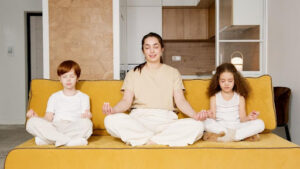
Parenting is hard work, especially as we move into the holiday season. There will be school events, family events, work events, and gift shopping, and you still need to be a parent among all those competing influences. One thing that might help you and your family is to take a moment, every now and then, slow down, breathe, and just be present for a few moments. By doing this you would be practicing mindfulness. When the word “mindfulness” is mentioned, several thoughts might come to mind; but do the words “easy” and “doing it with kids” typically come to mind? Probably not! But with a few tips that I’ll cover below, you can start implementing this practice and grow closer together as a family.
Benefits of mindfulness
Before we go over tips, I did want to just go over what mindfulness is and the benefits it can have for you and your family. First, mindfulness started as part of Eastern spiritual traditions such as Buddhism and Zoroastrianism. Over the years, mindfulness has been studied scientifically and has predominately been removed from a specific spiritual practice. Mindfulness itself has been modernly defined as being present in the moment and acting without reacting or judgment. In day-to-day life, this can look like taking a breath and not swearing when you get cut off in traffic, and maybe even sending that rude person a mental blessing or positive thought. Second, the benefits of practicing mindfulness have been well-documented over the years. Some of the most notable associations with mindfulness are its benefits for stress reduction, increased focus, better life satisfaction, and social-emotional development for children. There are so many great benefits to pausing, checking in, and being present. And doing mindfulness as a family would be a great ritual to help keep you grounded as you journey through this busy life together.
So, here are my tips for getting started with your mindfulness practice as a family.
- Start slow. If you start out trying to do a mindfulness meditation with your children that takes 10, 15, or 20 minutes plus, you are not going to be very successful. Start out with just doing a simple three- to five-minute meditation, or whatever time will work for you even if it’s just a minute.
- Be consistent. Mindfulness can have the greatest impact on us when we do it consistently. So, doing it every day or nearly every day can be a big help. Also, if you try and do it at the same time each day, this can help set up a routine.
- Focus on the small victories. Establishing a mindfulness routine is all about taking the small steps that lead up to a regimented practice. You won’t be an expert right off the bat, so it’s important to focus on the small ways you and your family make progress toward establishing a practice.
- Be gracious and forgiving. One of the tenants of mindfulness is to be gracious and forgiving to yourself. If you miss a few days or have some sessions that break down into silliness and laughter, still try and celebrate those moments and acknowledge the efforts you put in.
- Be creative, have fun, and make it your own. Like above, don’t take yourself too seriously. Often people feel like they have certain rules they need to follow or “it isn’t true mindfulness.” Do what you can to be creative and make this practice your own special process.
Example Exercise
 Instructions: Find a comfortable and quiet place to sit with your kid(s). You don’t have to dim the lights or put on quiet/calming music, but this can help make the environment more comfortable and make practicing mindfulness into a routine.
Instructions: Find a comfortable and quiet place to sit with your kid(s). You don’t have to dim the lights or put on quiet/calming music, but this can help make the environment more comfortable and make practicing mindfulness into a routine.
Read out the following while trying to practice what you are reading as well.
- As we try today’s exercise let’s try to find a comfortable sitting position. Go ahead and wiggle your arms, legs, and head if you need to. You can close your eyes if you want or just try to fix your eyes on one thing, something that is comforting. (Pause)
- After you find a comfortable position, go ahead and gently rest your hands on your belly. What do you feel? Do you notice your belly growing and shrinking as you breathe in and out? (Pause)
- For the next few moments, go ahead and try to focus on your belly as you breathe. Try to imagine that there is a little balloon in your belly that inflates and deflates with each breath. Also, try to slow your breathing and take nice, long but comfortable breaths. (Pause for a few breaths)
- Now, go ahead and return to a normal breathing pattern. As you do this try to focus on a happy memory or a person that makes you happy? (Pause)
- Think about what makes that memory happy for you or why that person makes you happy? (Pause)
- You don’t have to say this out loud, but what things come to mind? (Pause)
- How can you experience those feelings and thoughts more often? (Pause)
- How can you share those thoughts and feelings with others? (Pause)
- Now, just take a few more moments to focus on your breathing. And, whenever you’re ready, you can slowly become aware of your surroundings.
In conclusion
There are going to be so many things that are probably going to distract you from your family this holiday season. Further, life itself is busy enough, even without the holidays. Having a way to decompress and check in can help you and your family continue to take steps toward happiness and well-being together. So, the commitments of the holidays or life, in general, begin to pile up, please try to take a moment to pause, breathe, and focus on those wonderful things in your life.


This is great information and you put it together with such easy to follow directions. You did a great job!
Great article Mark. Thanks for breaking down what mindfulness is, and how to practice it with children who might struggle with conceptualizing this. Nice job!